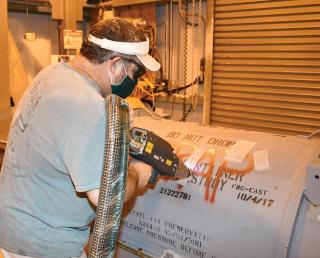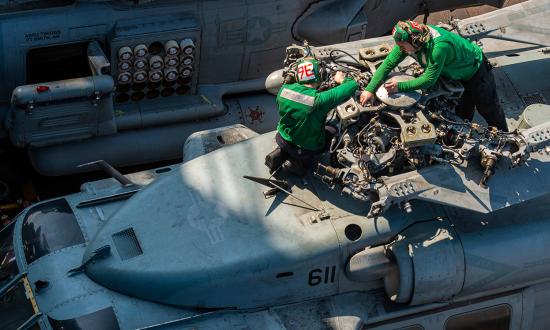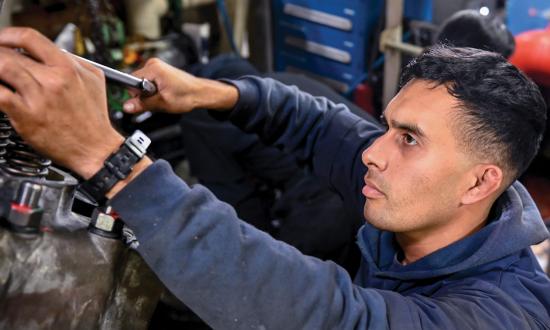While the U.S. Navy is constantly preparing for battle, it also is continually fighting corrosion. Corrosion is irrefutably taxing on ship structures and components. Corrosion control is a critical aspect of Navy maintenance to guarantee ships, submarines, and aircraft reach the end of their designed service lives. Paramount to corrosion control, resilient coatings protect surfaces in harsh environments.
When Navy assets are in depot-level maintenance, the service uses conventional methods such as chemical stripping, mechanical abrasion, and media blasting to remove rust and deplete protective coatings. In the future, the Navy should adopt laser ablation, a modern coating-removal technique, to optimize maintenance turnaround times, improve worker safety, and reduce environmental hazards.
The New Technology
Laser ablation removes material from solid metal surfaces with concentrated laser energy.1 Pointed at a metallic work piece and calibrated for the substrate it is cleaning, the laser emitted from a handheld gun vaporizes the organic and inorganic materials. Portable laser-cleaning technology uses a laser to vaporize a small amount of material from the metal surface, ultimately altering the surface structure, composition, and properties. Laser ablation is an effective cleaning tool for steel, aluminum, titanium, stainless steel, and other metals.
Laser ablation is selective in the depth of vaporized material. Only a tiny section of a metal part may be compromised by corrosion and need abatement. Repairing small sections via conventional abrasive blasting can contaminate the whole part and the surrounding workspace. Unlike with the more damaging conventional surface cleaning methods, laser ablation technology excels with sensitive metallic items. The company Adapt Laser demonstrated that laser ablation is the best midpower system for preweld and mold cleaning, paint and rust removal, and preadhesion cleaning.2 Waste from traditional paint-removal methods and processes is avoidable with laser-cleaning systems.
The emitted light energy from the laser significantly heats the substrate. The technology includes an integral failsafe mechanical limiter. The safeguard mechanism maintains uniform, treated surfaces. Compromising a ship structure results in poor performance and lifecycle reduction. However, there are no known significant negative effects to high-strength shipbuilding steel from laser ablation coating removal.3
Laser ablation involves a complex interaction between the laser beam and the metal surface, which can be affected by numerous factors, such as pulse duration, energy, and repetition rate. These parameters can affect the depth and extent of material removal and surface roughness. A close look with a high-powered microscope verifies substrate interactions from the laser’s applied heat. The smooth-flowing appearance of the surface finish suggests laser ablation does not impair ship structures.
For example, paint adhesion to steel samples treated with laser ablation yields much better performance compared with sandblasted steel samples.4 Achieving the desired results requires careful planning and attention to detail from the user. Because of material damage that occurs during a maintenance cycle, rework is counterproductive. Integrating laser ablation prevents unnecessary costs in the maintenance cycle.
More Efficient, Environmentally Friendly, and Safer
The Navy is reluctant to formally adopt laser cleaning for paint removal because developing a framework for corrosion removal requires a rigorous vetting process. Nevertheless, the Navy has documented certain benefits of laser-cleaning technology and is moving toward adoption, though some obstacles are worth noting. Laser-ablation demonstrations have increased over the past few decades, while the Army and Air Force have already begun adopting maintenance activities involving laser-cleaning technologies.5 However, the Navy’s barriers to adoption include the cost of the equipment and its uncertainty about effects of focused laser-energy absorption on shipbuilding structures.
Coating removal typically requires handheld power tools, such as needle guns, grinding wheels, or wire wheels, in the hands of skilled workers. In a head-to-head cost comparison of handheld and laser systems, handheld tools will always cost less. However, laser systems are more efficient and effective in treating surfaces.6 Portable laser-ablation equipment’s selectivity in removing epoxy paint layers of various thicknesses combined with its versatility in accessing areas handheld power tools simply cannot reach make it a better tool overall. Credible evidence of laser ablation’s advantages will no doubt accumulate to a point at which the Navy will be hard-pressed to continue with conventional paint-removal processes.
Painted surfaces wear and eventually require maintenance because of corrosion. Sailors spend many hours assessing compromised surfaces for corrosion, prepping the surface for paint adhesion, and coating surfaces with a fresh coat of paint. While the cost of laser-cleaning technologies is steep (initial investments range from $300,000 to $500,000), laser ablation’s production efficiency (fewer worker hours) will reduce spending on labor for cleanup and disposal of hazardous waste. Corrosion control with better technology would improve Navy readiness.
Worker safety is paramount to sustain Navy operations. The use of power tools for coating removal is labor intensive and, with repetitive motions, can lead to injuries to hands and forearms.7 To support shipyard activities and minimize hazards, the Navy adheres to Occupational Safety and Health Administration (OSHA) standards. OSHA requirements for abrasive blasting operations include ventilation, noise-dampening and personal protective equipment, respiratory protection, permissible exposure limits, and safe procedures for handling common media materials. Compliance with health and safety regulations is mandatory for all workers.
Adopting laser ablation would improve worker health and safety. For example, laser ablation is far quieter than sandblasting. Laser ablation employs a noncontact technique to remove material, eliminating the need for mechanical tools and significantly reducing the amount of noise produced. As a result, laser ablation allows for better communication and improved worker efficiency and safety. Indeed, laser-cleaning technologies give workers peace of mind that their hearing will not become impaired.
The Navy recognizes the responsibility to protect the environment and prevent harm to human health. As a result, stringent regulations and guidelines are in place to ensure hazardous waste is handled and disposed of properly. Implementing a comprehensive hazardous waste management program tailored to laser ablation implementation is the most cost-effective environmental-compliance approach to improve the Navy’s public image as good stewards of the environment.
Laser ablation can remove both surface contamination and paint simultaneously. And a paint-removal process typically comprising multiple steps is reduced to a single step. The Navy should formally adopt laser ablation for maintenance. The evidence is now clear that this method is safer and more environmentally friendly—and will cost the service less in the long term.
1. Robert L. Cargill, “Closed-Loop Laser Ablation for Navy Maintenance Applications,” paper for the American Society of Naval Engineers Intelligent Ships Symposium, 2011, www.lasertronics.com/wp/wp-content/uploads/2011/10/ASNE-2011-Symposium-Paper.pdf.
2. Adapt Laser, “Adapt Laser’s CL600 Is Navy-Approved,” adapt-laser.com, 30 July 2021.
3. Joha Shams, et al., “Effects of Laser Ablation Coating Removal (LACR) on a Steel Substrate: Part 1: Surface Profile, Microstructure, Hardness, and Adhesion,” Surface and Coatings Technology 281 (February 2015): 193–205.
4. Shams, et al., “Effects of Laser Ablation Coating Removal (LACR) on a Steel Substrate.”
5. Sarah Sicard, “Lasers Could Replace Sailors in Peeling Old Paint Off Ships,” Military Times, 9 July 2020.
6. National Center for Manufacturing Sciences, “Navy Seeks Demonstrations on Laser Ablation Coating Removal Capabilities,” 5 February 2019, www.ncms.org/navy-seeks-demonstrations-on-laser-ablation-coating-removal-capabilities.
7. Shams et al., “Effects of Laser Ablation Coating Removal (LACR) on a Steel Substrate.”







